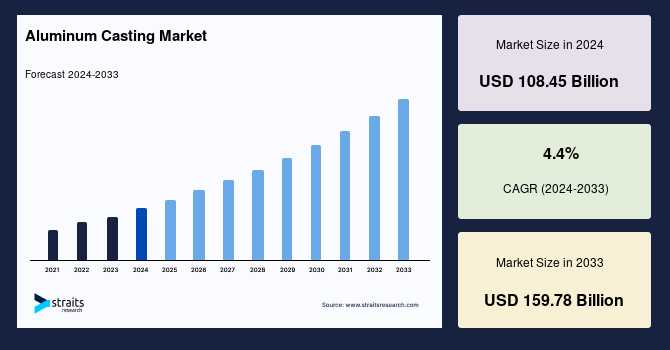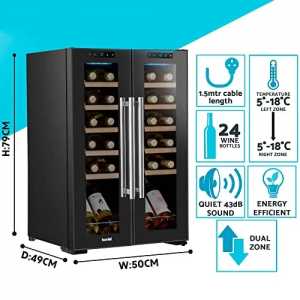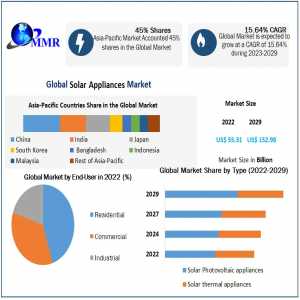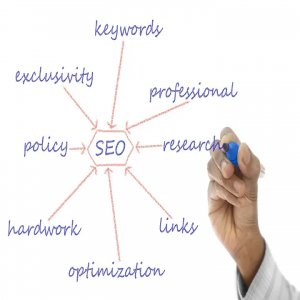
Aluminum Casting Market: Trends, Growth Factors, Opportunities, And Key Developments In 2025

Market Overview
Aluminum casting produces high-quality parts for diverse applications, offering dimensional stability, strength, and thermal conductivity. The market is segmented by type and application, with die casting and the transportation sector leading due to high demand for lightweight vehicle components. Asia-Pacific holds over 46% of the market share, driven by industrial growth in China and India.
By Type
-
Die Casting: Dominates with over 51% revenue share in 2024, used for automotive parts like engine blocks and gears due to precision and rapid production. It includes high-pressure, low-pressure, and vacuum die casting.
-
Permanent Mold Casting: Expected to grow significantly, producing smooth-finished components for motorsport and aerospace using reusable metal molds.
-
Sand Casting: Preferred for small-scale production, offering flexibility for complex designs in industrial and construction applications.
By Application
-
Transportation Sector: The largest segment, contributing over 56% of revenue in 2024, driven by demand for lightweight vehicles and aircraft components like engine blocks and chassis parts.
-
Industrial Sector: Growing due to aluminum’s use in machinery, heat exchangers, and equipment, supported by global industrialization.
-
Building and Construction Sector: Expanding with a 3.7% CAGR through 2030, using cast aluminum for structural supports and fittings in infrastructure projects.
For more Segmented report Click here :- https://straitsresearch.com/report/aluminum-casting-market/segmentation
Latest Trends
-
Sustainability Initiatives: Adoption of low-carbon aluminum and recycling processes, like Alcoa’s partnership with Nexans in 2024 for emission-free smelting, aligns with environmental regulations.
-
Digital Integration: Automation, AI, and 3D prototyping enhance casting precision and efficiency, particularly in die casting for automotive parts.
-
Lightweighting in Automotive: Increased use of aluminum castings in electric vehicles (EVs) for battery housings and structural components to improve range and efficiency.
-
Additive Manufacturing: Integration of 3D printing with casting processes enables rapid prototyping and complex geometries.
-
High-Performance Alloys: Development of advanced aluminum alloys for aerospace and automotive applications, offering superior strength and conductivity.
Growth Factors
-
Automotive Industry Demand: Stringent CO2 emission regulations and EV production drive demand for lightweight aluminum components.
-
Infrastructure Development: Rapid urbanization in Asia-Pacific boosts construction, increasing aluminum casting use in structural applications.
-
Aerospace Expansion: Rising aircraft demand, projected at 42,000 new units over 20 years, fuels need for cast aluminum in engines and fuselages.
-
Technological Advancements: Innovations in casting methods, like high-pressure die casting, improve efficiency and product quality.
-
Economic Growth: Rising disposable incomes and industrial investments in emerging markets support market expansion.
Opportunities
-
Electric Vehicle Market: Growing EV production offers opportunities for lightweight aluminum components, especially in battery housings.
-
Emerging Markets: Asia-Pacific and Latin America present growth potential due to industrial and infrastructure expansion.
-
Recycling Innovations: Investments in circular economy practices, like recycled aluminum casting, align with sustainability goals.
-
Aerospace Innovations: Demand for fuel-efficient aircraft components creates avenues for high-performance castings.
-
Construction Boom: Modular aluminum casting solutions in Indonesia and India reduce construction costs and time.
Key Players and Recent Developments (2024-2025)
-
Olson Aluminum Casting (U.S.): In 2024, expanded its sand casting capacity to meet industrial sector demand. No specific 2024-2025 mergers reported.
-
Rajshi Industries (India): Focused on permanent mold casting enhancements in 2024, targeting automotive and construction sectors. No mergers or deals noted for 2025.
-
Walbro: Strengthened its die casting portfolio for small engine components in 2024, with no specific 2025 mergers reported.
-
Alcoa Corporation: In 2024, partnered with Nexans to supply low-carbon aluminum for sustainable cable production, reinforcing its eco-friendly casting initiatives.
-
Consolidated Metco Inc.: Expanded aluminum casting operations in 2024 to support EV component demand, with no new 2025 deals reported.
-
BUVO Castings: In 2024, invested in automation for high-pressure die casting, enhancing automotive part production. No 2025 mergers noted.
Challenges
-
High Production Costs: Aluminum casting, especially die casting, requires significant investment, limiting entry for smaller manufacturers.
-
Raw Material Price Volatility: Fluctuations in aluminum prices impact production costs.
-
Environmental Regulations: Compliance with stringent emission norms increases operational costs for foundries.
Conclusion
The aluminum casting market is set for robust growth through 2033, driven by demand for lightweight, sustainable components in automotive, aerospace, and construction sectors. Die casting and transportation applications lead, while innovations in digital manufacturing and eco-friendly alloys create new opportunities. Key players are leveraging partnerships and capacity expansions to stay competitive. Despite challenges like high costs and regulatory pressures, the market’s focus on sustainability and technological advancements ensures a strong future.
To Get a detailed report here :- https://straitsresearch.com/buy-now/aluminum-casting-market
Frequently Asked Questions (FAQs)
-
What is the projected growth rate of the aluminum casting market?
The market is expected to grow at a CAGR of 4.4% from 2025 to 2033. -
Which segment dominates the market?
Die casting and the transportation sector dominate, with over 51% and 56% revenue shares, respectively, in 2024. -
What drives market growth?
Demand for lightweight vehicles, infrastructure development, and aerospace expansion are key drivers. -
How do sustainability trends impact the market?
Low-carbon aluminum and recycling initiatives, like Alcoa’s 2024 partnership, align with environmental regulations. -
Which region leads the market?
Asia-Pacific holds over 46% of the market share, led by China and India. -
What are the main challenges?
High production costs, raw material price volatility, and strict environmental regulations pose challenges.
Author Bio
Article Comments
No Comments!
At present there are zero comments on this article.
Why not be the first to make a comment?
Similar Articles
Search Pages
User Upgrade
account to full use of editor,
Including hyperlinks
Article Categories
There are zero sub-categories in this parent category.
There are zero sub-categories in this parent category.

















